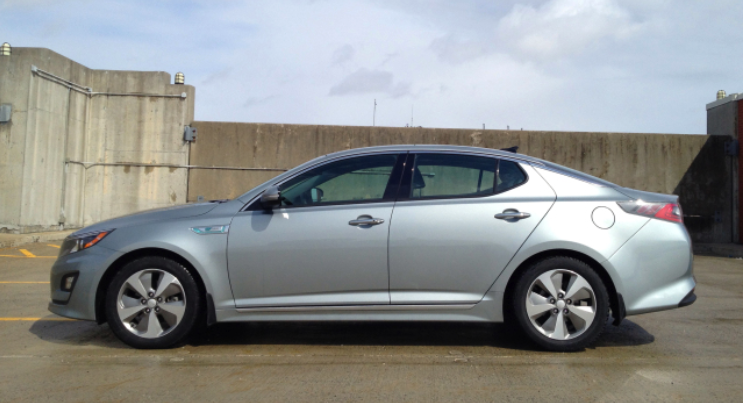Road Test: 2015 Kia Optima Hybrid

Story and photo by John LeBlanc
Thank high fuel prices and stricter government-mandated fuel economy ratings for today’s variety of gasoline-electric hybrid vehicles. Once limited to being quirky little cars when they arrived in the late 1990s (think first-gen Toyota Prius or Honda Insight), hybrids now come in all shapes and sizes, including family sedans like this 2015 Kia Optima Hybrid.
When it was introduced for 2011, the mid-size, five-passenger, front-wheel-drive Optima sedan was one of the first signals that Kia was becoming a serious contender to more established automakers. Stylish, feature-laden, and well made with excellent road manners, topline gas-engine Optimas have become legitimate alternatives to low-end versions of the entry-level luxury/sport sedans like the BMW 3 Series and Audi A4.
The hybrid version of the Optima arrived in late 2011, and it quickly found favour with buyers. Combined with sales of its Hyundai Sonata Hybrid platform-mate, the two family sedans ranked only behind the Toyota Prius in the hybrid sales race for 2011 in the U.S.
In 2013, a new electric motor added more horsepower. Combined with a 2.4-litre four-cylinder gas engine, output rose to 199 horsepower, and a higher-capacity lithium-polymer battery pack pumped the torque rating up to 235 pound-feet. The bigger battery also allowed for the Optima Hybrid to be driven up to 100 kilometres per hour in full electric mode via its six-speed automatic transmission. Then, for 2014, the Kia hybrid sedan received a slight design update, with new LED running lights and tail lights and front-end styling that was said to improve aerodynamics.
As you might expect, Kia has priced its 2015 Optima Hybrid competitively with rivals like its Sonata partner as well as hybrid versions of the Toyota Camry and Ford Fusion sedans. Well-equipped (highlighted by a multi-functional, leather-wrapped steering wheel, power driver’s seat, heated front seats and side mirrors, rear-view camera and Kia’s UVO infotainment system) base model Optima Hybrids start at $31,630 (all prices include freight and pre-delivery inspection fees). My Optima Hybrid tester was the top line, $38,230 EX Premium model. Going that route adds a bunch of goodies including a larger infotainment touchscreen, navigation, leather seats (that can be cooled and heated up front), rear parking sensors, plus a full suite of safety kit including blind-spot detection.
All of that ongoing engineering work has resulted in the Optima Hybrid posting fuel economy estimates of 6.1 litres per 100 kilometres in the city and 6.7 on the highway. During my week in the Kia sedan, at the tail end of a long and cold winter, I saw an indicated 7.4 L/100 km. But in a previous test in warmer weather, I recorded a 6.5 L/100 km average, which is pretty respectable for a mid-sized sedan.
Compared to the $26,190 Optima LX’s 192-hp naturally aspirated 2.4L gas engine (10.2 L/100 km city; 6.9 highway) and $36,290 SX Turbo’s 274-hp, 2.0L turbocharged gas-four (11.7 city; 7.7 highway) the Hybrid is obviously the Optima to buy if you want to burn less fossil fuel. But with gas versions of the new, second-generation 2016 Optima set to go on sale later this fall, we don’t expect the hybrid versions until well into 2016. So if you’re in the market for a hybrid family sedan, should you wait until then or consider a 2015 model now?
The answer to this depends on what your priorities are.
From what I saw of the pre-production 2016 models at the New York Auto Show, the interior of the forthcoming 2016 Optima is more about refinement than revolution. I’ve always liked the current Optima’s driver-oriented interior design and ergonomics. My top-rung EX Premium model saw leather applied thoughtfully to all the surfaces the driver touches on a regular basis. And the stitched, padded dashboard and massive UVO touchscreen infotainment make the family sedan feel more luxurious than its price suggests.
However, where I am hoping Kia will make more progress with the next Optima Hybrid is with its limited cargo capacity (caused by the battery pack in the trunk) compared to the gas versions, and how its gas-electric system behaves on the road.
The interaction between the Kia’s hybrid bits — toggling between the electric and gas modes and the regenerative braking system — show the automaker’s lack of hybrid powertrain experience. Starting off from a stop, there’s a slight hesitation from the Optima Hybrid’s engine department. And once underway, the engine revs up then down a bit, without any indication of a change from the speedometer. Weird.
Stopping the Kia hybrid is also a touchy affair. The regenerative braking system (which sends energy back to charge the batteries), grabs too much when the brakes are initially applied at lower spends. Once again, areas of refinement Toyota and Ford have already nailed down. Once up to speed, though, the Optima offers a fine highway ride, with an eerily quiet cabin.
As much as I like the 2015 Optima Hybrid’s exterior and interior styling, and its relatively parsimonious fuel economy, drivers may find its unrefined hybrid bits off-putting. But knowing Kia’s relentless pursuit of improving, I’m expecting big improvements with the next-gen Optima Hybrid.





![[del.icio.us]](https://www.straight-six.com/wp-content/plugins/bookmarkify/delicious.png)
![[Digg]](https://www.straight-six.com/wp-content/plugins/bookmarkify/digg.png)
![[Facebook]](https://www.straight-six.com/wp-content/plugins/bookmarkify/facebook.png)
![[Google]](https://www.straight-six.com/wp-content/plugins/bookmarkify/google.png)
![[Reddit]](https://www.straight-six.com/wp-content/plugins/bookmarkify/reddit.png)
![[StumbleUpon]](https://www.straight-six.com/wp-content/plugins/bookmarkify/stumbleupon.png)
![[Twitter]](https://www.straight-six.com/wp-content/plugins/bookmarkify/twitter.png)
![[Email]](https://www.straight-six.com/wp-content/plugins/bookmarkify/email.png)